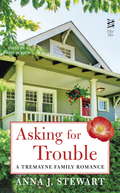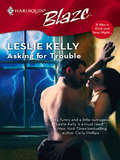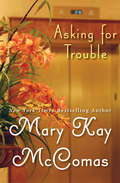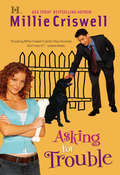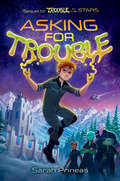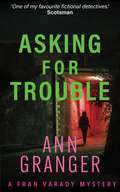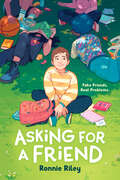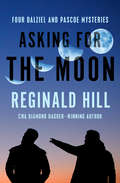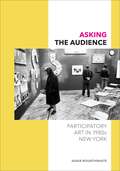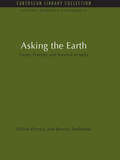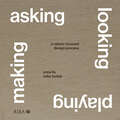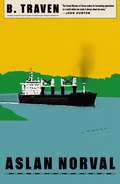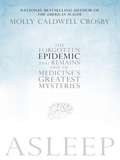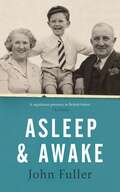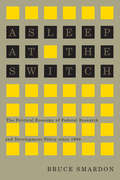- Table View
- List View
Asking for Trouble
by Anna J. StewartThe Tremaynes are one of the most prosperous families in Lantano Valley, California. But money can't buy everything--especially when it comes to love...Morgan Tramayne has a heart of gold, but to keep her children's charity afloat she's had to resort to some less than legal means: donations from a notorious cat burglar who targets the wealthy. It's only a matter of time before Morgan's criminal connection blows up in her face--especially since her undeniable attraction to the man heading the investigation keeps putting her in tricky situations.Former police detective-turned-investigator for the D.A. Gage Juliano has two goals: salvaging his career and nabbing Lantano Valley's present-day Robin Hood. But when he meets a beautiful, curvaceous woman who's more interested in helping others than amassing a fortune like the rest of the town's residents, Gage finds his desires pulled in an unexpected direction...Includes a preview of the second Tremayne Family Romance, Here Comes Trouble."A heartwarming romance filled with true to life characters--this story is a winner! You don't want to miss such a sparkling debut!"--New York Times and USA Today Bestselling Author Brenda Novak"Asking for Trouble is sexy, suspenseful, and still full of heart. Now I can't wait for the next installment of the Tremayne Family Romances!"--Eileen Rendahl/Eileen Carr, Author of The Messenger series and Veiled Intentions"Whip-smart dialogue, a tightly-woven plot, and heart-thumping intrigue make this a not-to-miss romance!"--International Bestselling Author Tracy Brogan"A wonderfully crafted, beautifully told romance."--New York Times and USA Today Bestselling Author Jane Porter
Asking for Trouble
by Leslie KellyIt was a dark and sexy night. . . ;and she was in Trouble. Really!Budding journalist Lottie Santori is dying to escape her overprotective family and experience a little sexual adventure. And her upcoming, out-of-town (thank God!) job, researching scary old Seaton House, offers some very definite possibilities. . . ;. Lottie has always had a thing for the tall, dark and mysterious type, and her reluctant host, sexy Simon Lebeaux, looks as if he can give her the thrill of a lifetime. But when she finds herself at the center of several surprising accidents, Lottie can only wonder if she'll last that long. . . ;.
Asking for Trouble
by Mary Kay MccomasA woman's search for enduring romance leads her to a television dating show, and into the arms of a man who seems just a little too perfect . . .Sydney Wiesman is looking for an electric, passionate love--and she's willing to do anything, even go on a television dating show, to make it happen. Tom Ghorman seems to have it all; he's smart, sexy, and funny. But, even though he was the best of the three suitors Electra-Love offered her, their first date was a monumental disaster--and now she has rehash it for everyone to see. As she faces a public display of complicated emotions, Sydney must decide if Tom is the guy of her dreams or her worst nightmare . . . and she is far from knowing all of his secrets. Will she give in to the unpredictable romance Tom offers, or will she return to a life of waiting for boundless love? This ebook features an extended biography of Mary Kay McComas.
Asking for Trouble
by Millie CriswellTake a cozy bed-and-breakfast, a missing guest and a mysterious stranger...throw in a pile of bones, a past-due bank loan and the cops...and it's no wonder innkeeper Beth Randall needs a vacation from her life!Her dizzy aunts mean the world to Beth, but could their dabblings in the occult have finally gone too far? Now handsome Dr. Brad Donovan has arrived on her doorstep looking for his missing father-last seen here at the Two Sisters Ordinary. Sure, Beth would love to explore the sudden attraction between them-but not if it means implicating her family in murder! Dating the doctor could be fun, but it's probably just, well...asking for trouble.
Asking for Trouble
by Sarah PrineasThe heartwarming and adventure-filled sequel to Trouble in the Stars, in which Trouble, an adorable but dangerous shape-shifter must travel the galaxy on a rescue mission with their best friend Electra and a troublesome baby shapeshifter. Perfect for fans of Greg van Eekhout and Geoff Rodkey.After the adventure and havoc of escaping the evil General Smag, Trouble is happy to finally be settling in to their new home with their best friend, Electra, and the misfit crew of the Hindsight. Maybe danger is finally behind them. But Trouble has a situation to deal with: training the rescued baby shapeshifter and helping it figure out who--and what--they are. But trying to be a good big sibling to a proto-being isn't the only challenge facing Trouble.Trouble's best friend, Electra, was taken from her home as a baby and was raised at a military academy, where she was trained to become a loyal StarLeague cadet. Now Electra is determined to rescue the other cadets so they can have normal childhoods instead of becoming lethal weapons, like her. Her plan? To infiltrate the academy as a senior student and then engineer an escape by the entire student body. Trouble knows they must help Electra carry out her plan. But when Electra goes missing, Trouble, determined to rescue the rescuer, goes undercover at the academy, even if it's not as easy as you'd think for a shapeshifter to pretend to be a military cadet. Especially when Trouble finds that the baby shapeshifter has come along.Now Trouble must do whatever it takes to save Electra and the other cadets--and figure out a strange mystery coming from the deep dark edges of space. Because something's coming...
Asking for Trouble (London Confidential #1)
by Sandra ByrdWhen a fifteen-year-old American girl finds herself living outside of London because of her father’s job transfer and becomes a columnist for the school newspaper, she learns to use Bible truths to dole out wise advice to her classmates but soon finds it hard to follow her own advice.
Asking for Trouble: A lively and gripping crime novel (Fran Varady Ser.)
by Ann GrangerThe death of a squatter is not all it seems...Ann Granger introduces the unemployed and soon-to-be-homeless amateur sleuth Fran Varady in the first of this riveting crime series. The perfect read for fans of Edward Marston and LJ Ross. 'It looks as if Ann Granger is on to another winner' - Birmingham Post Fran Varady is insolvent, unemployed and, though for the moment she's got the leaky roof of the squat she shares in Jubilee Street over her head, she'll very soon be homeless thanks to the council eviction department. Her dreams of becoming an actress, nurtured when her father and grandmother were still alive, seem a long way off. But Fran is a survivor ... which her former housemate, Terry, found hanging from the ceiling of her room, clearly is not.Terry, secretive and selfish, was far from popular with the rest of the household, but her death shakes the Jubilee Street Creative Artists' Commune, as the squat residents half-jokingly call themselves. And, the more Fran discovers about the death of the young woman whose life briefly intersected with her own, the more she begins to see it was not all it first seemed.What readers are saying about Asking for Trouble:'Fran is too good to confine to one book. What good news to learn that there is a series!''An intriguing storyline, described with humour and affection''Fran is a delightful character and one well worth following through the other parts of this series'
Asking for Trouble: A lively and gripping crime novel (Fran Varady)
by Ann GrangerThe death of a squatter is not all it seems...Ann Granger introduces the unemployed and soon-to-be-homeless amateur sleuth Fran Varady in the first of this riveting crime series. The perfect read for fans of Edward Marston and LJ Ross. 'It looks as if Ann Granger is on to another winner' - Birmingham Post Fran Varady is insolvent, unemployed and, though for the moment she's got the leaky roof of the squat she shares in Jubilee Street over her head, she'll very soon be homeless thanks to the council eviction department. Her dreams of becoming an actress, nurtured when her father and grandmother were still alive, seem a long way off. But Fran is a survivor ... which her former housemate, Terry, found hanging from the ceiling of her room, clearly is not.Terry, secretive and selfish, was far from popular with the rest of the household, but her death shakes the Jubilee Street Creative Artists' Commune, as the squat residents half-jokingly call themselves. And, the more Fran discovers about the death of the young woman whose life briefly intersected with her own, the more she begins to see it was not all it first seemed.What readers are saying about Asking for Trouble:'Fran is too good to confine to one book. What good news to learn that there is a series!''An intriguing storyline, described with humour and affection''Fran is a delightful character and one well worth following through the other parts of this series'
Asking for Truffle (A Southern Chocolate Shop Mystery)
by Dorothy St. JamesWhen Charity Penn receives a letter saying she won a trip to Camellia Beach, South Carolina complete with free cooking lessons at the town’s seaside chocolate shop, The Chocolate Box, she’s immediately skeptical. She never entered any contest. Her former prep school friend offers to look into the phony prize—only to end up drowned in a vat of chocolate.Struck with guilt, Penn heads to the southern beach town to investigate why he was killed. But as wary as she is of the locals, she finds herself lured into their eccentric vibe, letting her defenses melt away and even learning the art of crafting delicious chocolates. That is, until delight turns bittersweet as she steps straight into the midst of a deadly plot to destroy the seaside town. Now, only Penn’s quick thinking and a mysterious cask of rare chocolate can save the town she’s learning to love.Rich and decadent, Asking for Truffle, the first in a new cozy series by Dorothy St. James, is sure to be a delectable read for fans of JoAnna Carl and Joanne Fluke.
Asking for a Friend
by Kara H.L. ChenThis charming YA rom-com follows a strong-willed, ambitious teen as she teams up with her childhood frenemy to start a dating-advice column, perfect for fans of Emma Lord and Gloria Chao.Juliana Zhao is absolutely certain of a few things:1. She is the world’s foremost expert on love.2. She is going to win the nationally renowned Asian Americans in Business Competition. When Juliana is unceremoniously dropped by her partner and she’s forced to pair with her nonconformist and annoying frenemy, Garrett Tsai, everything seems less clear. Their joint dating advice column must be good enough to win and secure bragging rights within her small Taiwanese American community, where her family’s reputation has been in the pits since her older sister was disowned a few years prior.Juliana always thought prestige mattered above all else. But as she argues with Garrett over how to best solve everyone else’s love problems and faces failure for the first time, she starts to see fractures in this privileged, sheltered worldview.With the competition heating up, Juliana must reckon with the sacrifices she’s made to be a perfect daughter—and whether winning is something she even wants anymore.
Asking for a Friend
by Kerry ClareFor readers of J. Courtney Sullivan and Emma Straub, and for fans of Firefly Lane, comes a poignant and astute novel about life, love, and the ever-evolving nature of female friendship by the author of Waiting for a Star to Fall.The bottom of Jess&’s world is falling out. Cocooned in her dorm in the winter of 1998, she&’s reeling, and wants to be left alone. But a chance encounter with the older, otherworldly, elusive Clara has Jess awestruck. Clara, newly returned from a two-year trek drifting around the world, is taking a stab at normalcy for once, and the place she starts is university, where she struggles to fit in. Upon meeting Jess, though, Clara feels an instant connection, and everything seems brighter. Soon, the two are inseparable, undeniable necessities in each other&’s lives. But when tragedy strikes, they are unceremoniously torn apart, sent tumbling down different paths. And with each passing day, their unbreakable bond is tested more and more.As they endure love and heartbreak, marriage, anxiety and isolation, and the complicated existence of motherhood, Jess and Clara must learn how to love each other through it all—and whether growing up inevitably means growing apart.Spanning two decades, Asking for a Friend follows the tempestuous journey of female friendship, exploring whether its fundamentals—history, familiarity, loyalty—are enough to make the relationship everlasting.
Asking for a Friend
by Ronnie RileyEden Jones has exactly three friends. And they're all fake.From a web of lies and social anxiety to true friendship and queer joy; this is the wonderful second book from the author of the Indies Introduce and Indie Next List pick, Jude Saves the World.Why go through the stress of making friends when you can just pretend? It works for Eden and their social anxiety... until their mom announces she's throwing them a birthday party and all their friends are invited.Eden's "friends," Duke, Ramona, and Tabitha, are all real kids from school... but Eden's never actually spoken to them before. Now Eden will do whatever it takes to convince them to be their friends--at least until the party is over.When things start to go better than Eden expects, and the group starts to bond, Eden finds themselves trapped in a lie that gets worse the longer they keep it up. What happens if their now sort-of-real friends discover that Eden hasn't been honest with them from the very beginning?Author Ronnie Riley creates a world full of queer joy and all the ups and downs of true friendship.
Asking for a Friend: Three Centuries of Advice on Life, Love, Money, and Other Burning Questions from a Nation Obsessed
by Jessica WeisbergA delightful history of Americans' obsession with advice--from Poor Richard to Dr. Spock to Miss MannersAmericans, for all our talk of pulling ourselves up by our bootstraps, obsessively seek advice on matters large and small. Perhaps precisely because we believe in bettering ourselves and our circumstances in life, we ask for guidance constantly. And this has been true since our nation's earliest days: from the colonial era on, there have always been people eager to step up and offer advice, some of it lousy, some of it thoughtful, but all of it read and debated by generations of Americans.Jessica Weisberg takes readers on a tour of the advice-givers who have made their names, and sometimes their fortunes, by telling Americans what to do. You probably don't want to follow all the advice they proffered. Eating graham crackers will not make you a better person, and wearing blue to work won't guarantee a promotion. But for all that has changed in American life, it's a comfort to know that our hang-ups, fears, and hopes have not. We've always loved seeking advice--so long as it's anonymous, and as long as it's clear that we're not asking for ourselves; we're just asking for a friend.
Asking for a Pregnant Friend: 101 Answers to Questions Women Are Too Embarrassed to Ask about Pregnancy, Childbirth, and Motherhood
by Bailey GaddisThe Straight Scoop on the Questions That Make You Blush Why do I feel turned on when breastfeeding? Could an epidural paralyze me? Am I awful for feeling sad my baby isn&’t the sex I&’d hoped for? In this comprehensive new book, doula and birth educator Bailey Gaddis offers frank girlfriend talk and expert advice about pregnancy, childbirth, and early motherhood. During her own pregnancy, Bailey had many unanswered questions she felt were too taboo or embarrassing to ask. To help other women have a more informed, less cringey experience, she went on to train as a birth professional, and her work has inspired this book. Bailey consulted with medical experts and psychologists to ensure accurate answers to the featured questions, and she presents her sought-after expertise to you with thoughtfulness and humor. Her accurate, nonjudgmental answers to even the most embarrassing or scary questions will help guide you through pregnancy and the first weeks of motherhood with greater calm and confidence.
Asking for the Moon: Four Dalziel and Pascoe Mysteries (Dalziel and Pascoe #16)
by Reginald HillFour novellas in the “outstanding procedural series” exploring the past—and future—of this pair of Yorkshire police detectives (Marilyn Stasio, The New York Times Book Review). British investigators Dalziel and Pascoe have been praised as “witty, intelligent . . . two of the more interesting police detectives in modern crime fiction” (Publishers Weekly). In this collection, their Diamond Dagger Award–winning creator presents four imaginative tales featuring the duo. The first story explores the chilling start of the Dalziel and Pascoe partnership. In another, they investigate the fate of a woman no one has seen for a year—except her brother, who claims he is being haunted by her ghost. Then the detectives keep vigil at an isolated farmhouse, waiting to see what is making things go bump in the night. Finally, we take a jump in time to the twenty-first century and the partners’ last case: the first man murdered on the moon. “Reginald Hill is a mystery writer who is also a very good novelist. . . . [He] uses the police procedural format to get at something deeper than the solution of a crime. . . . Hill can capture a moment, an emotion, or a character with the stroke of a few words.” —The Washington Post Book World
Asking the Audience: Participatory Art in 1980s New York
by Adair RounthwaiteThe 1980s was a critical decade in shaping today&’s art production. While newly visible work concerned with power and identity hinted at a shift toward multiculturalism, the &‘80s were also a time of social conservatism that resulted in substantial changes in arts funding. In Asking the Audience, Adair Rounthwaite uses this context to analyze the rising popularity of audience participation in American art during this important decade.Rounthwaite explores two seminal and interrelated art projects sponsored by the Dia Art Foundation in New York: Group Material&’s Democracy and Martha Rosler&’s If You Lived Here…. These projects married issues of social activism—such as homelessness and the AIDS crisis—with various forms of public participation, setting the precedent for the high-profile participatory practices currently dominating global contemporary art. Rounthwaite draws on diverse archival images, audio recordings, and more than thirty new interviews to analyze the live affective dynamics to which the projects gave rise. Seeking to foreground the audience experience in understanding the social context of participatory art, she argues that affect is key to the audience&’s ability to exercise agency within the participatory artwork.From artists and audiences to institutions, funders, and critics, Asking the Audience traces the networks that participatory art creates between various agents, demonstrating how, since the 1980s, leftist political engagement has become a cornerstone of the institutionalized consumption of contemporary art.
Asking the Earth: Farms, Forestry and Survival in India (Natural Resource Management Set)
by Jeremy Seabrook Winin PereiraThe need to produce food without the destructive chemical horrors of much modern farming, for an intelligent use of dwindling natural resources and for humane forms of production is universal, the practice is limited. This book is an account of one, large, instance of success in practice. Twenty-five years ago, Winin Pereira, a nuclear physicist abandoned academia to start a co-operative farm at Alonde in a tribal area north of Bombay. The group experienced, and finally discarded, all the false hopes and promises of Western originated forms of development: ploughs that ploughed too deep, irrigation systems that lowered water tables, fertilizers and pesticides which managed the earth and became so expensive that poorer farmers were dispossessed. Instead they learnt from the adivasai, or tribal people, who have nurtured or been nurtured by foresets for millennia, ways of applying popular knowledge to contemporary problems. This book is a combination of Pereira's record of achievement of sustainable livelihoods and an account of the farm and its effect on the India around it by a leading British journalist. Originally published in 1991
Asking the Right Questions at the Right Time: Evaluating New Growth Opportunities
by Rowan Gibson Peter SkarzynskiWhat criteria should your company be using to evaluate new opportunities, and how do you know whether you are asking the right questions at the right stage of the idea development process? This chapter provides some guidelines for answering these important questions.
Asking, Looking, Playing, Making: A nature-focused design process
by Mike Tonkin Anna LiuDesign is a process requiring both rigour and freedom; focus and expansion. Yet how does the concept - the 'intention' - become a built project?This accessible book acts as a storytelling toolkit, taking designers through a tried-and-tested process for taking an architectural project from thought to built project. Based around four main sections - Asking, Looking, Playing and Making - the authors show how a design process can generate beautiful buildings which are rooted in a sense of place. Further examples include a range of project types and scales to demonstrate the versatility of this toolkit.
Aslan Norval: A Novel
by B. TravenB. Traven’s last novel, first published in 1960 but never before released in English, features a larger-than-life heroine: Ms. Aslan Norval, an American millionairess with Hollywood roots and political schemes up her sleeveThough Aslan Norval is wealthy beyond measure and contentedly married to an aging businessman, she finds herself tormented with the desire to do something epic, something no man has dared to do: she decides to build a canal across the continental United States. With the help of an uncouth Korean War veteran—whom she appoints as her right-hand man and unlikely lover—she forms a public corporation. A congressional committee of investigators, prodded by lobbyists, tries to stop the venture; but the ensuing publicity arouses the civic-minded public, and “democratic process” insists that the canal be realized as a federal undertaking. Not only will the project relieve chronic unemployment and demobilize the armed forces, but it will also benefit the Atlantic and Pacific fleets, aid world shipping, and relieve the Cold War!Rediscovered after B. Traven’s death in 1969, Aslan Norval is a hidden gem now unearthed—the final novel from the brilliant and beloved mind behind the cult classic The Treasure of the Sierra Madre—shedding new light on the life and work of a mysterious literary giant.
Asleep
by Banana Yoshimoto Michael EmmerichBanana Yoshimoto has a nuanced and magical ability to animate the lives of her young characters, and here she spins the stories of three women, all bewitched into a spiritual sleep. One, mourning for a lost lover, finds herself sleepwalking at night. Another, who has embarked on a relationships with a man whose wife is in a coma, finds herself suddenly unable to stay awake. A third finds her sleep haunted by another woman whom she was once pitted against in a love triangle.
Asleep
by Molly Caldwell CrosbyA fascinating look at a bizarre, forgotten epidemic from the national bestselling author of The American Plague. In 1918, a world war raged, and a lethal strain of influenza circled the globe. In the midst of all this death, a bizarre disease appeared in Europe. Eventually known as encephalitis lethargica, or sleeping sickness, it spread worldwide, leaving millions dead or locked in institutions. Then, in 1927, it disappeared as suddenly as it arrived. Asleep, set in 1920s and '30s New York, follows a group of neurologists through hospitals and asylums as they try to solve this epidemic and treat its victims-who learned the worst fate was not dying of it, but surviving it.
Asleep
by Molly Caldwell CrosbyA fascinating look at a bizarre, forgotten epidemic from the national bestselling author of The American Plague. In 1918, a world war raged, and a lethal strain of influenza circled the globe. In the midst of all this death, a bizarre disease appeared in Europe. Eventually known as encephalitis lethargica, or sleeping sickness, it spread worldwide, leaving millions dead or locked in institutions. Then, in 1927, it disappeared as suddenly as it arrived. Asleep, set in 1920s and '30s New York, follows a group of neurologists through hospitals and asylums as they try to solve this epidemic and treat its victims-who learned the worst fate was not dying of it, but surviving it.
Asleep and Awake
by John FullerAn elegantly jubilant and personal new collection celebrating love, life and creativity from award-winning poet and Booker Prize-shortlisted novelist, John FullerIn this personal and characteristically brilliant new collection from John Fuller, an abundance of memories abound. From “those once endless years” of a childhood in wartime – tasting of Granny’s chicken soup, twizzers and cherry-go-rips – to the pattern of family and friendships, important milestones are brought to vivid life. In ‘Before We Met – and After’ a sequence of recollections cherish a wife on her eightieth birthday; ‘In Whose Head’ a piece by Schumann is revisited through advancing years; and in ‘Keeper of the Fire’ and ‘In Memory of John Bayley’ late poems of remembrance memorialise lost friends. These are poems of being and time, full of lyric feeling and Fuller’s distinctive wit and lightness of touch. Alive with the clang and sway of the “chosen colours of daily family life”, together they form a resonant gathering of poems that celebrate, with thoughtfulness and joy, “the feel and length of our lives”.
Asleep at the Switch
by Bruce SmardonSince 1960, Canadian industry has lagged behind other advanced capitalist economies in its level of commitment to research and development. Asleep at the Switch explains the reasons for this underperformance, despite a series of federal measures to spur technological innovation in Canada. Bruce Smardon argues that the underlying issue in Canada's longstanding failure to innovate is structural, and can be traced to the rapid diffusion of American Fordist practices into the manufacturing sector of the early twentieth century. Under the influence of Fordism, Canadian industry came to depend heavily on outside sources of new technology, particularly from the United States. Though this initially brought in substantial foreign capital and led to rapid economic development, the resulting branch-plant industrial structure led to the prioritization of business interests over transformative and innovative industrial strategies. This situation was exacerbated in the early 1960s by the Glassco framework, which assumed that the best way for the federal state to foster domestic technological capacity was to fund private sector research and collaborative strategies with private capital. Remarkably, and with few results, federal programs and measures continued to emphasize a market-oriented approach. Asleep at the Switch details the ongoing attempts by the federal government to increase the level of innovation in Canadian industry, but shows why these efforts have failed to alter the pattern of technological dependency.
